Park and ride returns to Byron Bay
See how it worked last year
The park and ride Magic Bus will run from Byron Regional Sport and Cultural Complex on Ewingsdale Road into town from December 29 to January 4.
All-day parking will be available at the complex for $5 per car.
Mayor Simon Richardson, says the famous bus will travel via a dedicated bus lane into town, and ‘residents can be part of a solution to a well- known [traffic] problem.’
Additionally, a free shuttle will have two bus services each hour and operate between 10am and 8pm and up until 10pm on NYE.
‘We had more than 6,000 park and ride patrons last year and the feedback was very supportive,’ he says. ‘Each year, Council is aiming to build on the uptake. It’s fun, fast, and sure beats the pain out of sitting in traffic and then circling town trying to find a car park.’
Special Parking Areas
And like last year, a Special Event Parking Area (SEPA) will be in place during the same time.
Time limits will apply for Belongil and Wategos and the streets west, east and within the town centre.
‘Most streets in the SEPA area are residential, where no time limit is signed; however, during SEPA, a 2P time limit will apply for each 24-hour period. If you live within the area, exemption parking permits will be available to residents (and their guests), workers and accommodation providers.’
Collect your SEPA permit from the Mullumbimby Council office until 24 December, or the Byron Regional Sport and Cultural Complex until December 23 and from December 29 to January 4.
Find out more at the council’s website or call 6626 7000.
Byron Mayor on board for more park-and-ride trials
Updated Thu 16 Jan 2014, 11:47am AEDT
The Byron Shire Mayor says a park-and-ride trial conducted over the Christmas holiday period was a fantastic success.
Simon Richardson says about 6000 individual passengers used the service to get into Byron Bay’s CBD over three weeks.
He says on New Year’s Eve about 180 vehicles were left at designated drop-off points.
Cr Richardson says the system deserves another trial.
“We learnt on a daily basis, almost on an hourly basis the first couple of days and the next time when we roll it out we’ll be able to tweak it and obviously costs will come down significantly,” he said.
“But the really reassuring thing is that we had 70 per cent of the people that we surveyed gave it a 10 out of 10.
“So those who used it, virtually unanimously loved it, and will do it again.
“We want to make sure the next time we do it we’ve got sa bit more lead-in time, a bit more preparation.
“So (we might) be pitching towards mid year, or just try and make it really great for next summer, but with summer and the following Easter, something like that.”
Will bus bust Byron’s gridlock?
Mayor Simon Richardson with Sarah Ndiaye, Techa, Amalie, Tim and bus driver. Photo Jeff Dawson
Byron Shire Council – and no doubt many residents – are hoping their innovative park ’n’ ride scheme will end the annual carpark that Ewingsdale Road becomes at this time of year.
The bus will operate from Byron Regional Sport and Cultural Complex, Ewingsdale Rd, from Boxing Day (December 26) to January 12.
On New Years Eve only, it will also operate from Byron Bay High School, Bangalow Rd.
The park ’n’ ride bus will be free throughout the new year period except New Years Eve, when a one-off $30 fee will be charged.
The Magic Bus is the centrepiece of the council’s summer strategy for the new year period, which also includes one-off parking restrictions in town and free all-day earlybird parking in Butler Street.
A valid resident parking coupon or a yellow temporary Special Event Parking Permit will be required to exempt your vehicle from the two-hour special-event parking restrictions.
Byron mayor Simon Richardson is the first to admit not everything has rolled out entirely smoothly but, as he told Echonetdaily this morning, that’s the nature of a trial.
‘As a trial we’re already learning things now. There’s all sorts of little tiny things that we’ll learn from and do better. I’m walking the streets, trying to get to every business in Byron trying to make sure they all have coupons for their staff. But the overwhelming majority of people approve of what we’re doing and in the spirit of a trial we’ll no doubt learn things that we can do better next time.
Households and businesses should by now have received their two permits and are urged to contact Council at www.byron.nsw.gov.au if this is not the case or if they require more.
The Special Event Parking Area (SEPA) two-hour parking zones will stretch from Red Devil Park to Belongil and will be in force from December 26 to January 1 inclusive.
Mayor Simon Richardson said the purpose of SEPA was ‘to help prompt a change in behaviour’.
‘The amount of traffic coming into Byron Bay at the moment makes it harder for everyone. We were looking for a sustainable way forward, but whenever you have change, especially around car usage, you have trepidation.’
Echonetdaily will monitor the effectiveness of the changes and report back on them during the holiday period.
The twelve days of Christmas Parking – Park and Ride for Byron Bay
A twelve day Park and Ride scheme will be introduced as part of the Safe Summer in the Bay strategy.
“Traffic congestion and parking is one of the biggest challenges our locals and visitors face over the Christmas period,” Byron Shire Mayor Simon Richardson said.
“Providing affordable $5 all day parking at the Byron Regional Sport and Cultural Complex on Ewingsdale Road, and regular shuttle buses into town, is an obvious solution.
“If we can keep cars out of Byron Bay town centre, this is a big step towards improving traffic flow in the highly popular town.
“Areas of Byron Bay will be declared a special event parking area and a once a day 2 hour parking limit will apply.
“Parking at the BRSCC will be the most affordable all day parking in Byron, plus another advantage is the increased turnover in car parking spaces to help stimulate the retail economy,” he said.
From 26 December until 6 January, Council has declared Byron Bay a 2P Special Event Parking Area (SEPA). This means east of Belongil Bridge to south of Red Devils and everywhere in between, a 2 hour parking limit will be in effect, unless other parking laws apply.
For example, anyone can still park in the SEPA but needs to obey the posted time limits, be it 1P or 4P and where no time limit is signed the SEPA 2P limit applies. It also applies after other time limit areas expire, for example many streets are time limited until 6pm, after which the SEPA 2P limit will apply.
Exemptions to the SEPA 2P time limit are possible for “Permit Holders”, who is any Byron Shire resident that correctly displays a valid Resident Parking Coupon and by doing so allows, for example, parking all day in residential streets such as Butler Street.
Special edition 12-day SEPA permits will also be distributed for those residents who don’t already have a permit. These will be provided FREE, two per household, to those eligible. Those already holding a valid coupon do not need the extra 12-day permit.
As for those visiting Byron Bay, and think the existing 1P, 2P or 4P or the SEPA 2P time limit is insufficient, Council will operate a Park and Ride service from the Byron Regional Sport and Cultural Complex (BRSCC) between 10am and 10pm, except on New Year’s Eve where it will extend services to 2am and also operate from the St Finbar’s and high school cul-de-sac on the southside. Except on NYE, park and ride will cost $5 per day per vehicle and provide all day parking. On NYE Park and Ride will cost $30.
Free all-day, “early bird” parking will also be made available for the twelve days at the Butler Street Reserve, except Thursday Farmers Market (2 Jan) and Sunday market day (5 Jan). Vehicles will need to be parked by 10am and can not leave the car parking space until 3pm. The Reserve will be closed at 6pm to car parking.
Byron Shire Mayor Simon Richardson said, “We’re always looking for new ways to help things run more smoothly for residents and visitors alike. Between the Park and Ride option, more available spaces and 2P Special Event Parking times we hope to do just that.”
More information on these measures will be provided to households.
———————————————————————————————————-
Sustainable Traffic & Parking Project
Park and Ride~ Pedestrian Zones~ Parking Management
Written and compiled by Mayor Simon Richardson, November, 2012
The Project
Introduce a park and ride scheme to take cars off the roads travelling to Byron Bay, sustainably manage visitor traffic, create a pedestrian mall on Jonson Street and modify parking zones to allow for shorter stays, thus encouraging vehicle to use long term parking options outside of town.
Project Component 1- Park and Ride (P&R)
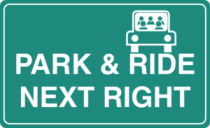 Park-and-ride (or incentive parking) facilities are car parks with connections to public transport that allow commuters and other people headed to city centres to leave their vehicles and transfer to a bus, rail system (rapid transit, light rail, or commuter rail), or carpool for the remainder of the journey. The vehicle is stored in the car park during the day and retrieved when the owner returns. Park-and-rides are generally located in the suburbs of metropolitan areas or on the outer edges of large cities.[1]
Park-and-ride (or incentive parking) facilities are car parks with connections to public transport that allow commuters and other people headed to city centres to leave their vehicles and transfer to a bus, rail system (rapid transit, light rail, or commuter rail), or carpool for the remainder of the journey. The vehicle is stored in the car park during the day and retrieved when the owner returns. Park-and-rides are generally located in the suburbs of metropolitan areas or on the outer edges of large cities.[1]
Why do we need Park and Ride in Byron Bay?
Shirley Street is increasingly becoming a parking lot. This is causing great disruption to those travelling for work purposes and both residents and visitors travelling to town or the beach. Every study ever commissioned has concluded:
- Traffic into Byron Bay is a serious problem that will only worsen.
- Most cars are venturing into Byron Bay and not through it
- Traffic congestion, parking difficulties and an unfriendly pedestrian environment has negative economic, social, environment and cultural effects for residents and visitors
- Alleviating these problems will be advantageous for both visitors and residents of the Shire.
AADT (Average Annual Daily Traffic) data for 2004 indicates that over 20,000 vehicles a day crossed the railway tracks on Lawson Street, Byron Bay. To put this figure in perspective, this was almost double the amount of daily traffic on the Pacific Highway at Ewingsdale and about half the number of vehicles crossing the Queensland border at Tweed Heads.[2]
The most recent study states, somewhat conservatively, “Although the existing network is already showing signs of operating close to or beyond its capacity (long queues, delays, and poor travel time reliability), it is generally confined to weekends and/ or peak periods of the day. The occurrence of these visual signs is irregular and generally confined to summer holiday period; however, they appear to be increasing in occurrence.” This will only get worse, as projected figures indicate a 30% increase on traffic by the end of 2028.[3]
We know the main reason for the congestion and parking stress are ‘day trippers’- visitors without accommodation and thus, nowhere off street to park vehicles. In 2011, 797,000 people visited Byron Bay for the day and considering the projected growth figures, the need for action is clear.[4] “By 2031, based on current trends, the population of the NSW Far North Coast Region will have grown by 60 400 people. Over the same period, South East Queensland is projected to grow by 1.1 million people (about 22% of Australia’s population growth). Of this growth, it is expected that about 300 000 more people will reside in the directly adjoining areas of the Gold Coast and Beaudesert in addition to the 530 000 people who currently live there. This projected growth for South East Queensland will have a significant influence on the Far North Coast. “[5]
Increased traffic along Shirley Street also creates added pressures in town, as cars seek parking spaces. Although we accept that at certain times of the week and at certain times of the year there is considerable pressure on car parking when demand from permanent residents, short stay visitors and day trippers exceeds supply of available parking spaces, this is consistent with most other popular places in Australia and the rest of the world. The Byron Bay Traffic Study suggests at least 15% of traffic in the town centre is actually circulating traffic looking for a carpark.
Aside from resident’s frustrations, either trying to move through Byron Bay for work purposes or simply to access the beach and town, the current traffic problems particularly along Ewingsdale Road/Shirley Street are seen very negatively by visitors. A recently commissioned visitor satisfaction report illustrated the negative impact traffic and parking has on visitors. The two highest areas of dissatisfaction for visitors surveyed were ‘parking’ and ‘level of local traffic in Byron Bay’.[6] Doing nothing could jeopardize a nearly half a billion dollar a year industry.
It is clear that traffic is one of the constraints on the number of visitors Byron Bay can handle. There is only so much traffic Byron can handle before the very things that attracts visitors to Byron in the first place is destroyed. For residents, there is only so much traffic we will tolerate before we feel the tourism industry is impinging unacceptable on our quality of life.
History of Park and Ride investigations
Park and ride, traffic, transport and town livability challenges have been considered in various forms and to various degrees for decades. Council has already endorsed the exploration of park and ride as a viable, logical and vital component of its transport portfolio.
2010
Byron Shire Council, Draft Transport Strategy.
Council identified Park and Ride Services and Byron Bay Town Centre Traffic: Congestion Relief and Improved Access as two of five strategic transport actions.
2008
Resolution 08-776
This resolution included the following, “That core community concerns requiring consideration of specific actions in the development of a low carbon polluting transport network as part of a financially, ecologically and socially sustainable transport strategy include:
a) a reduction in road traffic levels and congestion through the expansion of an alternative transport network throughout the shire
b) improved safety and residential amenity resulting from reduced road traffic
e) increased rate of cycleway and alternative transport network development
f) light rail solutions, particularly in and around Byron Bay (e.g. town tram service)
g) park and ride facilities as a key part of tourism management
h) need for high level of integration between tourism and transport management, including how to encourage tourists to visit and move around the shire by alternative or public transport.
2002
Development of an Appropriate Parking Strategy for the Byron Bay Town Centre – a Discussion Paper.–Veitch Lister
The report recommended, “A more remote car parking site on Ewingsdale Road should be identified and reserved for future use as a park and shuttle bus facility. A similar site should also be identified and reserved on the southern approach to the Town Centre.”
2001
Traffic & Parking Policy Framework for Byron Bay-Veitch Lister
This report considered park and ride and concluded it could play it could play a role in alleviating parking difficulties.
1999
Improving the Town Centre- towards an integrated traffic reduction strategy for Byron, Engwicht, D
Advocated and promoted the benefits of a park and ride system and the creation of a pedestrian mall
1998
Feasibility Study: The Environmental Adaptation of Jonson and Lawson Streets, Byron Bay, Geolink
As part of the consultation process, a public meeting was conducted on the evening of Wednesday 29 July. When asked, “What aspects of the study area could be improved, just over 50% responded, ‘A mall in the study area (particularly in Jonson Street.)’
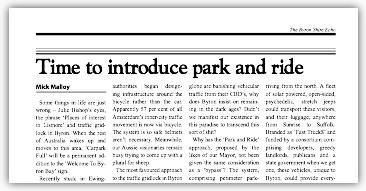
Park and Ride has been considered and advocated across many years. Here, the Byron Echo joins the chorus
Recent Community and Governmental support
2012
Community Strategic Plan
As articulated at a recently convened information session held by the RDA in Lismore, a Council’s Community Strategic Plan (CSP) should illustrate both need and acceptance of the initiative. Our CSP regularly outlines the need to alleviate our traffic problems, develop sustainable tourism management outcomes, promote liveability on our streetscapes and make our towns work for their residents. In fact, this project fits within the overarching vision of the CSP, “Culturally rich and thriving communities living in harmony, responding positively to the challenges of our world, and leading by example
The links within the CSP to the community’s support for the alleviation of our traffic problems, developing sustainable tourism management outcomes, promoting liveability on our streetscapes and making our towns work for their residents, are numerous.
2011
Northern Rivers Regional Plan- Regional Development Australia
Importantly, the Infrastructure, traffic, transport and tourism pressures confronting Byron Bay are regularly referenced. They are explicitly referenced within
- 3 regional issues and priorities (page 7,8)
- guiding principles
- at least 11 principles of regional significance, (page 11)
- social capital and economic capital- desired future characters and outcomes
- SWOT analysis- Opportunities and Threats
How would Park and Ride work in Byron Bay?
Step by Step
To assist in the scheme the following would occur during the process for the visitor:
Before leaving home:
Through marketing and web based information, the visitor will be made aware of that part of the Byron Experience’ will be to leave the car out of town, similar to the French Alps, Noosa, Venice or Whistler. Being car free will be part of the Byron Experience.
Parking:
- Directional signage will make it easy for visitors to find and access the carparks. A parking guidance system could be provided that measures long term car park occupancy in the CBD and provides information to drivers approaching Byron Bay. The information could be in the form of “Spaces”, “Near Full” or “Full” for each of the car parks.
- Cars will park in the designated sites, coming from the north, at the Byron Regional Sports and Cultural centre (BRSCC) and from the south, either Byron High School or Red Devil Park.
- The car spaces would be lit and secure.

The BRSCC- park and ride was considered in its creation. There are 275 paved car spaces available, plus a large sports oval of similar size for overflow.
Waiting to board
- Visitors will be greeted by ‘ambassadors’, friendly hosts who can give out information
- Photos could be taken in front of fun boards, ‘magic buses’ etc.
- Creative, interactive activities could be available, like the wonderful musical swings in Montreal.
- These aspects would all be present in the locations for boarding on the return journey.
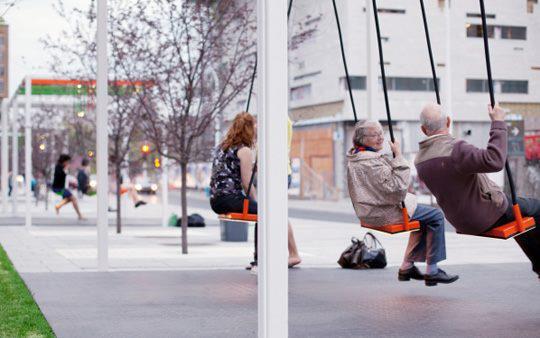
Montreal- every summer they put up a series of musical swings. If you look in the background you can see more people swinging away. Each swing is a set of four and has its own unique sound, but if you are in perfect harmony with the other 3 seats then an actual song is played. The theory is that you communicate and interact with people more if it’s for a specific goal and if you’re having fun
The Bus Journey
- ‘Byron Experience’ People Mover-It is envisaged that this would be a commercial enterprise. Council could charge a licence fee, either only to cover their own costs or as an actual source of revenue, if the service is commercially successful. At this stage, it has been assumed that the service would be cost neutral to Council.
- Visitors will board a bus; paying a nominal fee (perhaps $5 per person return or $10 return per car)
- Buses will pick up every 15 minutes and drop off passengers at main beach, next to the surf club and the current Jonson street bus stop.
- The buses will be equipped with storage spaces for surfboards and beach gear. The best examples are airport shuttle buses, both small and effective in transporting passengers with huge amounts of luggage.
As the scheme finds its feet, other commercial operations could be operated in conjunction with the park & ride facilities, providing transport options such as bike hire, a horse and cart along the beach, utilising the rail line, rickshaws etc
The Route
- The ‘Byron Experience’ People Mover will travel on a transit lane along Shirley Street, (also for use by Taxi’s and emergency vehicles)
- It will use a second lane and modified Shirley/ Butler Street roundabout
- Its first stop will be to a newly created (temporary) waiting area at Bay Street, Main Beach, before completing the block and stopping at the major bus stop on Jonson Street in front of the Byron Visitors Centre.
Will it work?
In order for Park and Ride schemes to be successful, they generally require the following conditions to be in place as noted in the Austroads Guide to Traffic Management Part 11: Parking.
- A limited and high cost public car parking system. A Park and Ride scheme would also require constraints on parking in the town centre. The free parking spaces would be changed to a shorter time, say ½ hour and one hour.
- A fast public transport service relative to the car – this can be achieved with the installation of a transit lane for buses, taxi’s and emergency vehicles.
- A frequent and reliable public transport service between the park-and-ride facility and the central area, with an adequate capacity, on-site security and providing a pleasant travelling environment
- A competitive fare for the park-and-ride journey to/from the central area.
Whilst more detailed investigations and feasibilities reports would clarify the impacts more thoroughly, some clear and continued expert opinion have stated. “ It will be the contention of this report that the entry car park could remove as much (or more) traffic from the town centre as the bypass- at significantly less cost- with a gradual, ‘no regrets’ implementation possible.”[7]
For Visitors: From Car Park- to Experience
It is crucial to consider the psychology of the tourist experience’ It is largely agreed by researchers, that, “it is easier to get someone who is in their visitor persona to reduce their car usage than it is to get someone in their work-a-day persona to reduce theirs, particularly if the visitor is promised an increased tourist experience.”[8] With an openness to take more time getting from A to B, the benefits multiply. It will become a ‘point of difference’ from other coastal towns, something the business sector identifies as crucial for economic development.
Studies of the impact of making the centres of large European towns virtually cars free, has shown that retail sales have actually increased. [9]
For Residents
Residents who work or intend to stay for the day in Byron Bay will also use the service. Resident workers can leave the car and not worry about parking issues. In fact, anecdotal evidence from Noosa suggests that residents are a huge proportion of the users.[10] Extra benefits for residents include being exempt from payment, or obtaining a yearly pass, in line with the current car parking voucher.
Residents on-street permit schemes will be needed for the residential areas near the CBD. This would serve a dual purpose; to reduce the impact on residents of visitors parking in their streets and to encourage use of the car parks and of the park and ride services. It is envisaged that permits would be issued to the occupants of each dwelling, rather than the owners. This would allow for holiday tenants to qualify for the permits. Where there is a high turnover of tenants, some system would be needed to ensure that the permit was passed on to each new tenant. It is envisaged that permits would be required for more than one or two hours on-street parking during business hours
Examples from Noosa and Elsewhere
A recent conversation with a past Mayor of Noosa Shire highlighted the ease and overall simplicity of the project, the low cost of its implementation, the success in traffic and parking minimisation and the economic benefits for Noosa Heads businesses and traders.
Noosa began its journey towards park and ride from the Hastings Street and Noosa Junction Precincts Car Parking Strategy. In 2004 a study was undertaken to determine options for better managing car parking and traffic in the Hastings Street and Noosa Junction precincts. Hastings Street and its approach roads are particularly vulnerable to congestion at peak holiday periods. The objective of the study was to identify a preferred option for managing this traffic, reducing congestion and increasing the person capacity of both precincts whilst acknowledging that there will be progressively increased demands placed on the transport network over time.
Though it is worth noting that the Noosa model provides free bus rides, it serves as a wonderful and appropriate case study of a coastal, highly visited, nationally regarded and transport constrained town. The Noosa model has been highly successful, as the following extract from the Noosa News, 22nd Dec 2009 shares,
” There might be no such thing as a free lunch, but in Noosa the free bus is very much alive over the peak holiday period. Sunshine Coast council has joined forces again with TransLink and Tourism Noosa over Christmas/New Year to help prevent gridlock from spoiling the good times and choking up the biosphere.
The free holiday bus was pioneered in Noosa and is now spreading down the Sunshine Coast. Those who were around in the 1990s, before free buses started running, might recall Noosa Parade and other destinations becoming temporary parking lots as tempers flared.”
Note that ‘tempers flared’ is written in past tense.
Noosa’s Satisfaction surveys are positive, 1200 people participated in either face-to-face intercept or online surveys conducted from 26 December 2011 to 31 January 2012.
Key Findings included:
- 75% of respondents were Sunshine Coast residents
- 96% of respondents supported the program
- 83% had already travelled on a Free Holiday Bus
- 93% were extremely satisfied and 63% were satisfied with their journey
- 64% would use public transport in the future as a result of travelling on Free Holiday Buses.
- The main purpose for travelling on buses was recreation (51%) or shopping (33%)
Mount Desert Island (USA), home to Acadia National Park, has instituted a free seasonal shuttle bus to permit continued growth in tourism without continued growth in traffic congestion and vehicle emissions. On Mount Desert Island, about 1.7 million people visit in the peak three months (an average of about 19 000 people per day).
Aspen (USA) has established a non-profit car sharing organisation to reduce the residential parking demand.
Research also shows great success across the European Alps and literally hundreds of towns, including many coastal towns in the UK, continental Europe and elsewhere. It currently operates in Hobart as well as Queensland. The project would be not only regionally significant, but would be a first for NSW.
As it develops, other transport modes may add to the choice for the user; e.g, bike hire, horse and cart using the beach for access, or other entrepreneurial methods.
Project Component 2- Jonson Street Pedestrian Mall
- With the huge decrease in traffic and thus, parking requirements, a pedestrian precinct could be created along Jonson street, improving the liveability and character of the street.
- This could also allow for temporary, pop up type businesses, or market stall operations, creating employment, vibrancy and colour in the street
- Busking sites could also possibly be created.
- Nothing attracts a crowd like a crowd, thus the business benefits could be significant. Ideas to engage the patron of the mall are aplenty, for example, shopkeepers could provide chalk for road murals, flexible seating arrangements could abound, car spaces could be artistically designed. Once established, ideas and ways to engage with the space and develop interactive opportunities for residents and visitors alike could abound.
Project Component 3- CBD Parking
The Byron Bay Traffic Study suggests at least 15% of traffic in the town centre is actually circulating traffic looking for a carpark. Thus, less cars entering town, equals less cars circling. The traffic searching for a parking space can be reduced by a combination of providing a convenient car park at the entry to town and by operating a parking guidance system using variable message signs to indicate when car parks are full or nearly full. This will be an essential adjunct to any options providing additional parking in the precinct. Also, by introducing hundreds of extra car spaces in the park and ride scheme, some CBD car spaces could be used for bike racks, or town beautification works.
With less pressure on car spaces, and to create incentives for the use of the park and ride scheme, free car space times could be shortened to allow residents and workers to complete their tasks and business without having to compete for car spaces with those wishing to leave their cars for hours. Thus, it will be easier for someone to go into town to use the post office, do some banking, grab some take way etc, creating a more usable town for residents.
Further Benefits
Revenue raising
The scheme could provide income for the BRSCC, turning it, at a minimum, into a cost neutral community site. It could also be a great revenue generator for either the Byron Bay Rugby Club or Byron Bay High School.
Environmental gains
It will decrease vast amounts of carbon emissions; there is nothing environmental about sitting in a traffic jam.
There are also many intangible benefits, such as the improved environmental situation increasing the attractiveness of Byron Bay as a whole.
Supporting and progressing other traffic projects- bringing the Bypass closer
This initiative is not the panacea to all of Byron Bay’s transport woes. A bypass will still be needed to assist those moving through town do so within an acceptable time frame, thus, the park and ride scheme is envisaged to work alongside a bypass development to allow mobility to occur.
In particular, the redesign and development of an appropriate roundabout at the Shirley Street/Butler Street is a vital part of the infrastructure required for a bypass. Thus, by building it as part of the P&R project, the bypass is also further progressed.
Wider Business benefits
- It will create a point of difference from other coastal towns, increasing visitor satisfaction
- It will allow quicker mobility for residents wishing to pass through town, especially from the Arts and Industry Estate to Suffolk Park.
- It will create commercial opportunities at the park and ride car park sites.
A new Bus Transit Station
The interstate and regular bus services could use the park and ride carpark, allowing hostel buses to also meet visitors there. This will free Jonson Street from the inconvenience of Bus traffic and parking and would open up the railway station park and wider precinct for revitalisation and development. Importantly, it will still drop visitors in front of the visitors centre as part of the bus loop.
Bottom Line
The creation of a park and ride scheme will: take cars off the road, generate income for both sites, allow for a pedestrian zone, help progress bypass options, could be cost neutral to Council and 50% of costs incurred to make it happen would be covered by the Federal Government.
[1]Wikipedia.
[2]Byron Shire Council, September 2010 Draft Transport Strategy – Page 11 of 24
[3]MR545 Strategic report, 2006, page 6
[4]Tourism NSW and Tourism Research Australia
[5]Far North Coast Regional Strategy - New South Wales Department of Planning December 2006
[6]Tourism Research Australia, 2011
[7] Engwicht, D: Improving the Town Centre- towards an integrated traffic reduction strategy for Byron, 1999
[8] ibid, page 5
[9]Engwich, page 10
[10]Conversation with ex mayor of Noosa and Sunshine Coast Councils, Bob Abbott
















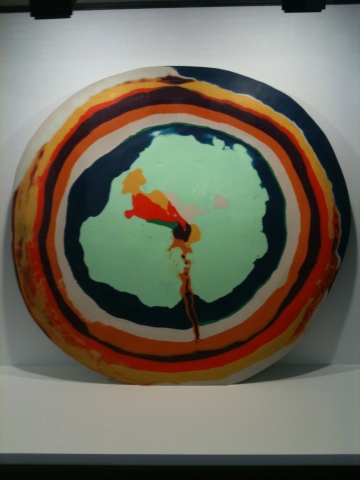

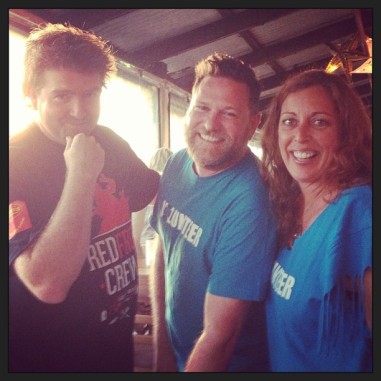

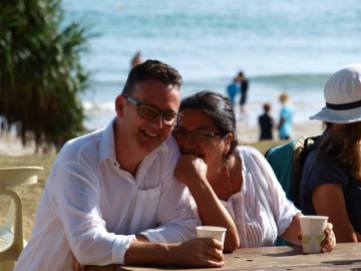










































































































































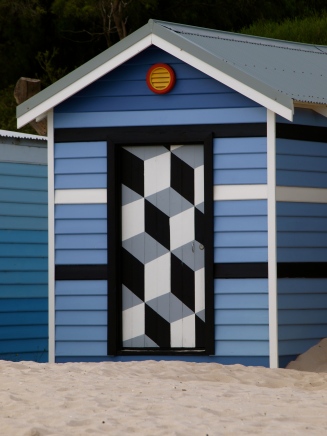


Excellent idea, it must be put into practice, all these ideals must become more than a talk fest and become reality. Maggi